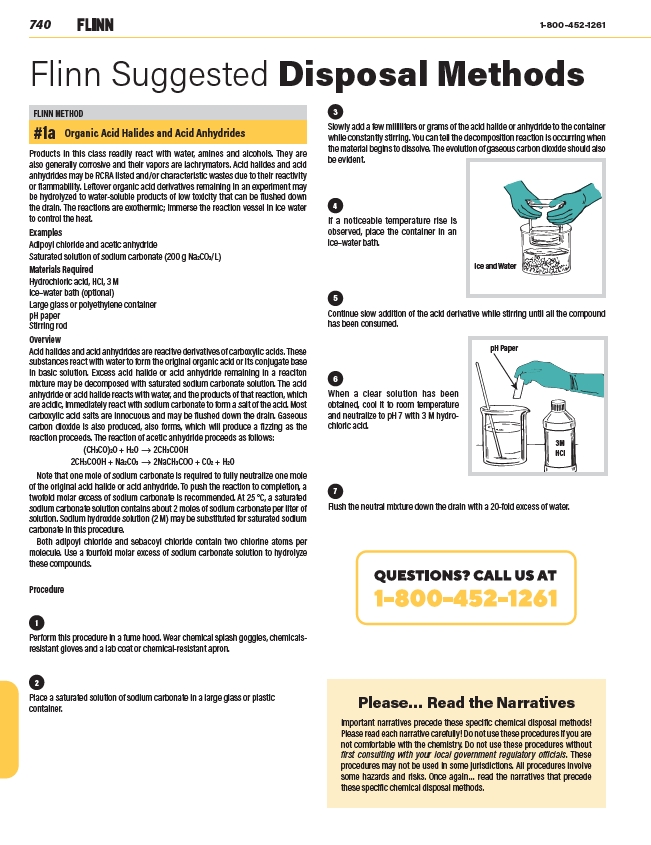
740 1-800-452-1261
Flinn Suggested Disposal Methods
FLINN METHOD
#1a Organic Acid Halides and Acid Anhydrides
Products in this class readily react with water, amines and alcohols. They are
also generally corrosive and their vapors are lachrymators. Acid halides and acid
anhydrides may be RCRA listed and/or characteristic wastes due to their reactivity
or flammability. Leftover organic acid derivatives remaining in an experiment may
be hydrolyzed to water-soluble products of low toxicity that can be flushed down
the drain. The reactions are exothermic; immerse the reaction vessel in ice water
to control the heat.
Examples
Adipoyl chloride and acetic anhydride
Saturated solution of sodium carbonate (200 g Na2CO3/L)
Materials Required
Hydrochloric acid, HCl, 3 M
Ice–water bath (optional)
Large glass or polyethylene container
pH paper
Stirring rod
Overview
Acid halides and acid anhydrides are reacitve derivatives of carboxylic acids. These
substances react with water to form the original organic acid or its conjugate base
in basic solution. Excess acid halide or acid anhydride remaining in a reaciton
mixture may be decomposed with saturated sodium carbonate solution. The acid
anhydride or acid halide reacts with water, and the products of that reaction, which
are acidic, immediately react with sodium carbonate to form a salt of the acid. Most
carboxylic acid salts are innocuous and may be flushed down the drain. Gaseous
carbon dioxide is also produced, also forms, which will produce a fizzing as the
reaction proceeds. The reaction of acetic anhydride proceeds as follows:
(CH3CO)2O + H2O → 2CH3COOH
2CH3COOH + Na2CO3 → 2NaCH3COO + CO2 + H2O
Note that one mole of sodium carbonate is required to fully neutralize one mole
of the original acid halide or acid anhydride. To push the reaction to completion, a
twofold molar excess of sodium carbonate is recommended. At 25 °C, a saturated
sodium carbonate solution contains about 2 moles of sodium carbonate per liter of
solution. Sodium hydroxide solution (2 M) may be substituted for saturated sodium
carbonate in this procedure.
Both adipoyl chloride and sebacoyl chloride contain two chlorine atoms per
molecule. Use a fourfold molar excess of sodium carbonate solution to hydrolyze
these compounds.
Procedure
1
Perform this procedure in a fume hood. Wear chemical splash goggles, chemicalsresistant
gloves and a lab coat or chemical-resistant apron.
3
Slowly add a few milliliters or grams of the acid halide or anhydride to the container
while constantly stirring. You can tell the decomposition reaction is occurring when
the material begins to dissolve. The evolution of gaseous carbon dioxide should also
be evident.
5
Continue slow addition of the acid derivative while stirring until all the compound
has been consumed.
6
When a clear solution has been
obtained, cool it to room temperature
and neutralize to pH 7 with 3 M hydrochloric
acid.
pH Paper
3M
HCl
7
Flush the neutral mixture down the drain with a 20-fold excess of water.
2
Place a saturated solution of sodium carbonate in a large glass or plastic
container.
4
If a noticeable temperature rise is
observed, place the container in an
ice–water bath.
Ice and Water
Please… Read the Narratives
Important narratives precede these specific chemical disposal methods!
Please read each narrative carefully! Do not use these procedures if you are
not comfortable with the chemistry. Do not use these procedures without
first consulting with your local government regulatory
officials. These
procedures may not be used in some jurisdictions. All procedures involve
some hazards and risks. Once again… read the narratives that precede
these specific chemical disposal methods.